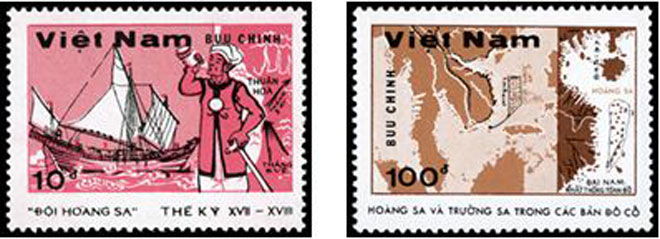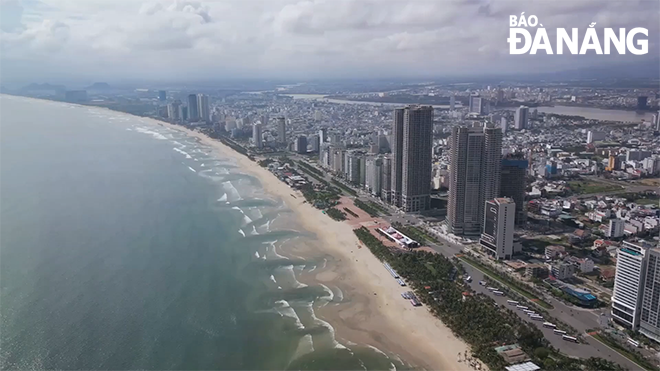Images of Da Nang on postage stamps
Postage stamp is an impressive way for localities to effectively promote their brand.
 |
| A set of two stamps about Hoang Sa and Truong Sa archipelagoes, designed by artist Tran Luong, was released on January 19, 1988. |
Only one year after the country's reunion day, Da Nang appeared on stamps with the images of the Hoang Sa (Paracel) Archipelago in the East Sea which was under the administrative management of Hoa Hai Commune, Hoa Vang District, Quang Nam - Da Nang Province at that time.
On June 24, 1976, a collection of postage stamps featuring Viet Nam’s reunion on which a map of Viet Nam, along with a bronze drum, with two archipelagos of Hoang Sa and Truong Sa, printed was released.
It can be said that this was the first set of Vietnamese revolutionary postage stamps with images of the Hoang Sa and Truong Sa archipelagoes under the country's indisputable sovereignty.
However, a set of two stamps designed by artist Tran Luong and released on January 19, 1988 is the only one focusing on introducing these two archipelagoes.
The first stamp introduced the image of the Hoang Sa (Paracel) Flotilla in the seventeenth and eighteenth centuries. Meanwhile, the second one showed the image of two ancient maps. In which, the larger map to the left of the stamp was the drawn by Dutch navigator Henricus Van Langren painted Viet Nam's Hoang Sa and Truong Sa archipelagoes in the shape of a pennant flag with the name Ile de Pracel in 1595. The smaller one to the right of the stamp was ‘Dai Nam Thong Nhat Toan Do’ (Complete Map of Unified Dai Nam) published during Nguyen Dynasty, in which the two archipelagos of Hoang Sa and Truong Sa were drawn into a strip of 29 islands with the common name ‘Hoang Sa - Van Ly Truong Sa’.
 |
| A set of stamps about the 1975 Spring General Offensive and Uprising was released in late 1976. They were designed by three painters, namely Trinh Quoc Thu, Tran Luong and Tran Ngoc Uyen. |
Nearly half a year after the release of a collection of the unified Viet Nam stamps, a set of stamps about the 1975 Spring General Offensive and Uprising was released in late 1976.
Designed by three painters, namely Trinh Quoc Thu, Tran Luong and Tran Ngoc Uyen, the stamp collection showed three important milestones in the historic Ho Chi Minh campaign to liberate the South and reunify the country: the Buon Ma Thuot Victory (March 12, 1975), the Liberation of Da Nang (March 29, 1975) and the Liberation of Saigon (April 30, 1975).
This set consists of six stamps but features three image designs of three historical events, printed repeatedly in two different denominations, of which the stamps about the Liberation of Da Nang has two denominations of 3 cents and 1 coin.
And in 1988, after the set of stamps about Hoang Sa and Truong Sa archipelagoes was released, Da Nang again appeared in a set consisting of seven stamps and a stamp block which introduced some famous tourist attractions in Viet Nam. Accordingly, there was the image of Marble Mountains - a scenic spot of Da Nang that was ranked as a special national-level relic site in 2018.
Especially, the stamp block features the whole map of Viet Nam, contributing to affirming the national sovereignty over the Hoang Sa and Truong Sa archipelagoes. This probably means that the beloved Hoang Sa Archipelago of Da Nang was once again printed on the stamp.
 |
| The image of Tran Thi Ly Bridge was printed on the only stamp sample to welcome in the 2017 APEC Economic Leader’s Week. Photo: B.V.T |
Since Quang Nam-Da Nang Province was officially divided into the 2 administrative divisions of Quang Nam Province and Da Nang in 1997, Da Nang has become a centrally governed city and has had strong development conditions, especially in the field of urban embellishment.
Among many titles associated with the central coastal, there is the title of Da Nang - a city of bridges. And it is no coincidence that two bridges spanning the Han River have been introduced on postage stamps.
Specifically, a set of stamps about Vietnamese bridges was released in 2002 with Long Bien in Ha Noi, Trang Tien in Thua Thien Hue, My Thuan connecting Tien Giang with Vinh Long, and Han River in Da Nang.
Released in 2019, a collection of stamps about cable-stayed bridges in Viet Nam introduced the Bai Chay Bridge in Quang Ninh - the only single-plane cable-stayed bridge in Viet Nam, the Nhat Tan Bridge in Ha Noi, the Phu My Bridge in Ho Chi Minh City - one of the most modern cable-stayed bridges in the world designed with two H-shaped towers, the Rach Mieu Bridge connecting Tien Giang with Ben Tre - the first bridge in Viet Nam completely designed and constructed with an inverted V-shaped tower, and the Tran Thi Ly Bridge in Da Nang which uses a three-way cable-stayed system with a 12-degree inclined pillar.
In fact, two years ago, the Tran Thi Ly Bridge was printed on a stamp, but not in a separate stamp template like the 2019 stamp, but in the only template of stamp welcoming in the 2017 APEC Economic Leader’s Week together with the Khue Van Cac (the pavilion of the constellation of literature) in Van Mieu - Quoc Tu Giam and the Ben Thanh Market. These are considered as symbols of three Vietnamese cities hosting the 25th Asia-Pacific Economic Cooperation (APEC) Summit Week, namely Da Nang, Ha Noi and Ho Chi Minh City.
Moreover, the image of Da Nang appeared in a set of stamps about the 5th Asian Beach Games released on July 1, 2016 with two stamps showing two beach sports with images of Vietnamese athletes on the background of Da Nang beach.
Most recently, Da Nang has received happy news as the cable car system on the Sun World Ba Na Hills Tourist Area that once achieved the world record from the World Travel Awards in 2019 will be printed on one of the three stamps about modern cable car systems to be released in April 2023.
On its development way, Da Nang possesses a lot of tangible and intangible cultural heritages that deserve to appear on stamps, including Dien Hai Citadel, Hai Van Gate, Vong Hai Dai, Museum of Cham Sculpture, and Thoai Ngoc Hau Temple.
Of course, in a time when electronic mail is almost universal, postage stamped letters are not popular, but they still retain the role of connecting people with people. Therefore, appearance on stamps is still an effective and impressive way to promote the image of localities in general and Da Nang in particular.
Reporting by BUI VAN TIENG - Translating by M.DUNG








